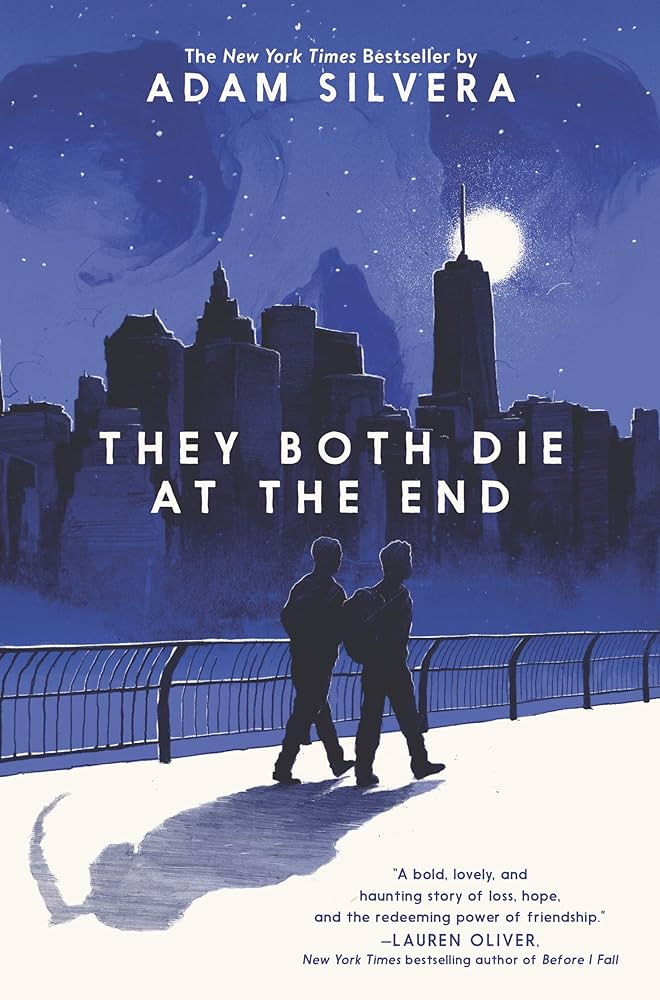They Both Die at the End by Adam Silvera is a science fiction novel about the significance of time. The narrative setting resembles our current world except for one difference: Death-Cast. As a technological program, Death-Cast informs people of the day they would die. In particular, a Death-Cast employee would call the victim on the exact day they would pass away. The purpose of Death-Cast isn’t to scare the public; instead, it is to make sure that their fatal day doesn’t go to waste.
In the book, Death-Cast notifies the two main characters—Mateo and Rufus—that they will both fall to their demise. When this heartbreaking news reaches them, Mateo and Rufus find themselves in distinct circumstances. Mateo is rotting in his bedroom, scrolling through his laptop in the dead of night. As someone who has constantly sheltered himself his whole life, the call makes Mateo feel an incentive to go out and make something of himself. Meanwhile, Rufus is assaulting a kid for revenge. After Rufus receives this call, he breaks down and starts rebuilding his life back up right after it shattered into pieces. He has a new family that loves him and will always stick by him, and Rufus would do anything not to lose them.
Rufus and Mateo somehow meet and spend their final day with each other despite all of their contrasting characteristics. For example, Rufus is more outgoing and confident in himself and enjoys exploring new areas and elements of his life. Meanwhile, Mateo has always preferred a life without any changes, sticking to the same narrative his entire life. They fully open up about their past, their relationships, and what brought them to where they are now. Throughout the hours they spend together, Rufus gradually persuades Mateo to break out of his enclosed shell and be the person he truly wants to be. Mateo has never really felt a connection like the one he’s sharing with Rufus, so he soon establishes a deep and intimate bond with Rufus. In turn, Rufus willingly accepts this relationship as his emotions are nurtured by Mateo’s loving spirit.
However, what doesn’t feel right about this book is the section where they fall in love. Normally, people don’t love someone to the extent Rufus and Mateo do in such a short period of time—less than a day, to be exact. Instead of love, they have more of a shared infatuation. For instance, they’ve both lived difficult lives with few people to rely on. Furthermore, Mateo and Rufus find each other in the same vulnerable situation by chance, which is what truly attracts the two of them together. Their romance therefore feels forced instead of natural, adding an unwanted “artificial feel” to the narrative.
This novel illustrates that it doesn’t matter how much time you have or who you choose to spend time with. Instead, it is how you spend it that matters. Mateo and Rufus were strangers before Death-Cast called them. If not for Death-Cast, Mateo and Rufus would have never met, and neither of them would’ve approached each other due to their distinct personalities and demeanors.
The joy you derive from this story depends on what type of reader you are. Personally, I would only recommend this book to someone who enjoys a slow read and doesn’t mind a short love story. Each chapter of this book feels as if it elaborates too heavily on every single detail of Mateo and Rufus’ journey, which may not be enjoyable for readers who prefer action-packed texts. The embellishment of each element quickly began to feel repetitive, which overall worsened my experience of reading. However, the pacing of this novel is understandable, since its narrative spans only a day. If you are someone who enjoys a slow-paced, detailed novel that describes the protagonist’s journey thoroughly, you should give this book a try!
Categories:
Book Review: They Both Die at the End by Adam Silvera
0





